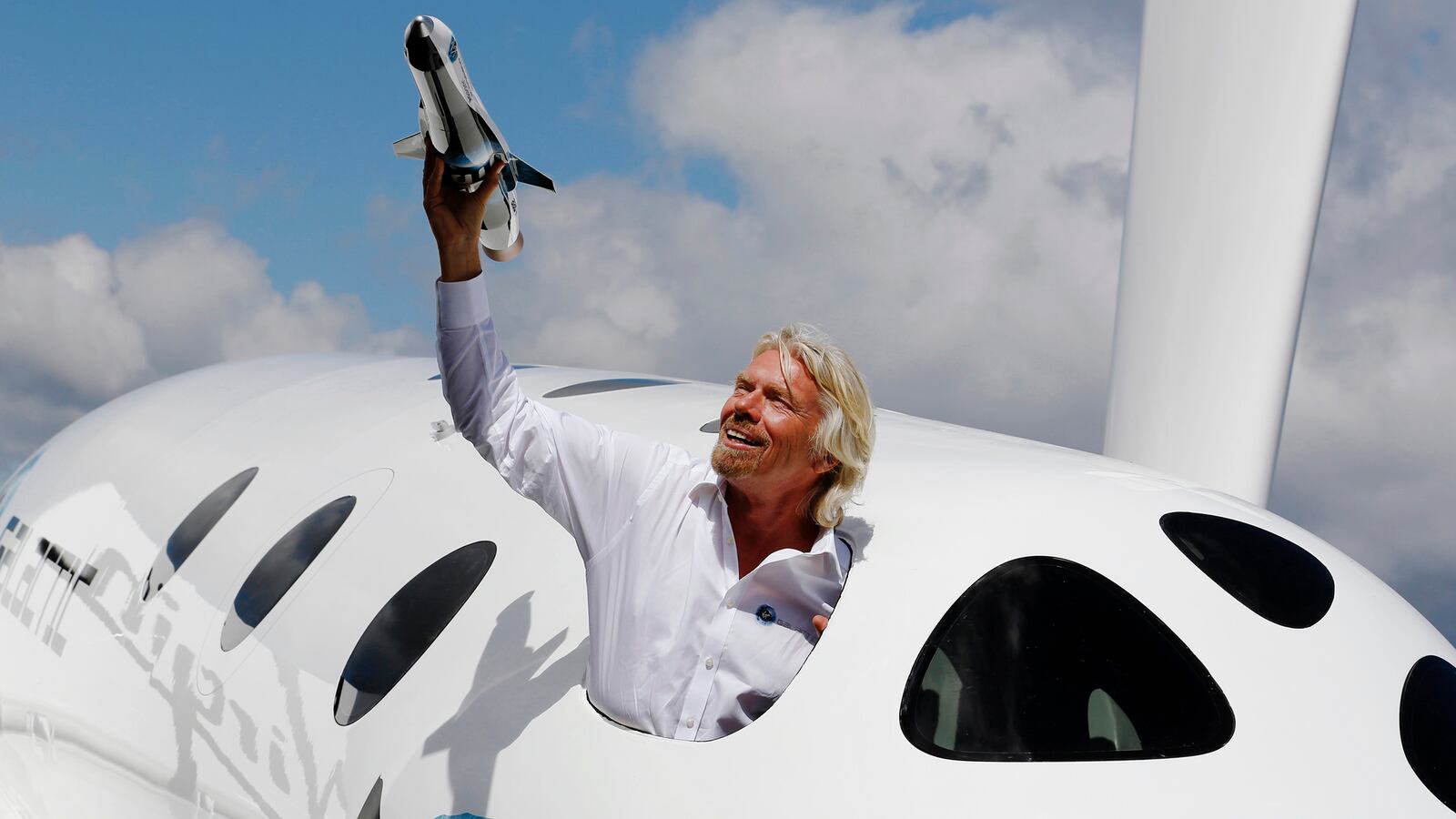Will Richard Branson’s long-touted rocket ride into space via his Virgin Galactic enterprise ever happen?
A new book, Branson Behind the Mask, by investigative reporter Tom Bower (to be published by Faber & Faber on February 6) casts serious doubt that it will.
In fact, there is little in Bower’s book that is not already known about Galactic’s dismal record so far. Branson presents an easy target because he has so frequently over-promised on his bid to introduce so-called space tourism.
The first passenger-carrying flight was supposed to happen in 2007. The date then slipped to 2009…2010…2011…2012…2013…and now to later this year.
Don’t hold your breath.
The fact that the project retains any credibility at all is due to two very different things. First, Branson’s boundless optimism and relentless promotional machine that seems to turn skeptics into road kill. Second is the fact that engineers who really understand what Galactic is trying to do say that there are so many technical challenges involved, so many things that have to work that haven’t been done before, that a prudent manager would not have expected (or predicted) quicker results.
Then there is the gap between the language and the reality.
“Galactic” was an absurdly romantic tag to attach to the program. There will be no venturing beyond gravity’s pull.
What is basically being attempted is a ballistic, sub-orbital flight, like a ride atop a short-range missile. Technically the border of what is called space is set at 62 miles above earth. Virgin Galactic’s SpaceShipTwo will reach an apogee of 68 miles. Then it will—without power—fall back to earth.
As that fall begins, the six passengers aboard will enjoy about five minutes of weightlessness before SpaceShipTwo assumes a controlled glide back to the Virgin Galactic Spaceport in New Mexico. To be sure, the views will be gob-smacking, but they won’t include galaxies.
Bower’s most serious claim, supported by little evidence, is that SpaceShipTwo’s rocket motor is not powerful enough to achieve the velocity necessary to reach 68 miles above earth with two pilots and six passengers aboard.
So far, there have been three rocket-powered flight tests. The first, in April last year, reached 55,000 feet and a top speed of 920 mph; the second achieved a speed of 1,100 mph as did the third, this month, which also reached the highest point yet, 71,000 feet.
To reach its target, SpaceShipTwo must be flying at 2,500 mph after just over a minute of rocket burn. (Compare this to the 17,500 mph needed to break free of gravity and go into orbit, and you can see the relative modesty of the aim).
Bower seems not to understand that all flight-testing is incremental. The pilots cautiously edge their way to maximum speed in stages. At each stage they have to monitor the behavior of the whole machine as it experiences new stresses—they don’t blast through the sound barrier like hotshots from the days of the The Right Stuff.
For example, on a test last year during an unpowered flight in a glide, the pilots encountered an unexpected handling problem, a tail stall. Bower reports alarmingly that, according to witnesses on the ground, the space ship “dropped like a rock and went straight down.” But even the most sophisticated airliners experience problems like this during testing and, as happened in this case, get some aerodynamic fine-tuning to fix them.
Bower traces the history of Galactic’s choice of rocket motor and, critically, the fuel it uses, a combination of nitrous oxide and rubber. On its website Galactic claimed that the fuel is “benign, stable as well as containing none of the toxins found in solid rocket motors.”
He cites two rocket engineers, Geoff Daly and Caroline Campbell, who contest this claim. Campbell is quoted saying “Nitrous oxide can explode on its own.” And she adds that Virgin’s fuel could be toxic—“there’s so much soot coming out the back. That’s burning rubber. That could be carcinogenic.”
The worst event in the development of this rocket motor was an explosion during a test of the fuel in 2007 that killed three of the forty engineers observing the trial in the Mojave Desert. Blame for the deaths fell on lax safety measures, which allowed the victims to get too near to the test site. The problem was not in the fuel itself but in the construction of the test tank. A rocket engine isn’t like a jet engine that you can power up or down. Basically, it’s a controlled explosion that you can only turn on or off.
Responding the charges in Bower’s book, Richard Branson said,“Rome wasn’t built in a day. Sending passengers into space is a little more complex.”
To be sure, though, beyond Bower’s alarmist scenario, there are some truly daunting problems facing SpaceShipTwo before it can fly any passengers.
And all of them concern safety.
The first is how the FAA can certify the craft as safe for passenger flight. It takes as many as two years, sometimes longer, for them to clear a new airliner for service, and this involves extremely well understood technical issues and mostly very mature technology. When it comes to airliners, there is little that has never been done before, and most of that involves software, not structure.
Nothing in the Galactic program has been done before. Until SpaceShipTwo actually reaches its target performance with six passengers aboard, nobody can tell how it will behave.
The test flights remain far short of creating those conditions. All normal certification standards are in abeyance, and the FAA, which cannot apply any of the certification checks normal for a commercial airplane flight, will have to be extremely conservative. (A Boeing engineer familiar with NASA’s certification of the now defunct Shuttle program told me that far greater risks are accepted for space flights than would be allowed in commercial flight).
The second is the physical state of passengers. Astronauts and test pilots are normally the only people who get to fly at supersonic speeds and experience the forces at play at this kind of velocity. They train for months and take frequent physical checks. Galactic’s passengers will surely have to be rigorously screened before taking such a hot ride.
And that leads directly to a third issue: what kind of insurance will be in place to cover passengers? Especially when, at $200,000 a flight, the passengers will mostly be high net worth individuals with families and businesses averse to derring-do.
Then there is the notion of space tourism itself and its social impact.
I spoke about Galactic to a NASA astronaut (who cannot be named as a matter of NASA policy). He was dubious about the whole concept of space tourism, which, he said, was more a frivolous stunt than a worthwhile scientific venture. And he added that Virgin Galactic was more likely to harm the environment than enhance it, with a rocket that burns “dirty”—the soot caused by the combustion of the rubber is clearly visible in the exhaust of the test flights.
Virgin Galactic may be behind their original schedule, but their enthusiasm hasn’t been dampened. In a statement issued this week, the company said, “With each test flight we are progressing closer to our target to start commercial service in 2004.”
As for Richard Branson himself, Bower’s book makes clear that he is a buccaneer by nature, a charismatic risk-taker often intoxicated by his own hyperbole, with little patience for detail or reflection, physically courageous but with a magpie mind flitting from one passion to another. It’s clear that he launched Virgin Galactic without remotely understanding the complexity of the technical challenges involved and, probably, still doesn’t.
The program is burning through money as fast as the rocket motor burns through fuel. The total cost so far is nearing a billion dollars. More than a third of the financing comes from Aabar, an investment fund based in Abu Dhabi. As a trade-off for those funds, Galactic is committed to creating a Spaceport in Abu Dhabi—a place that loves excess.






